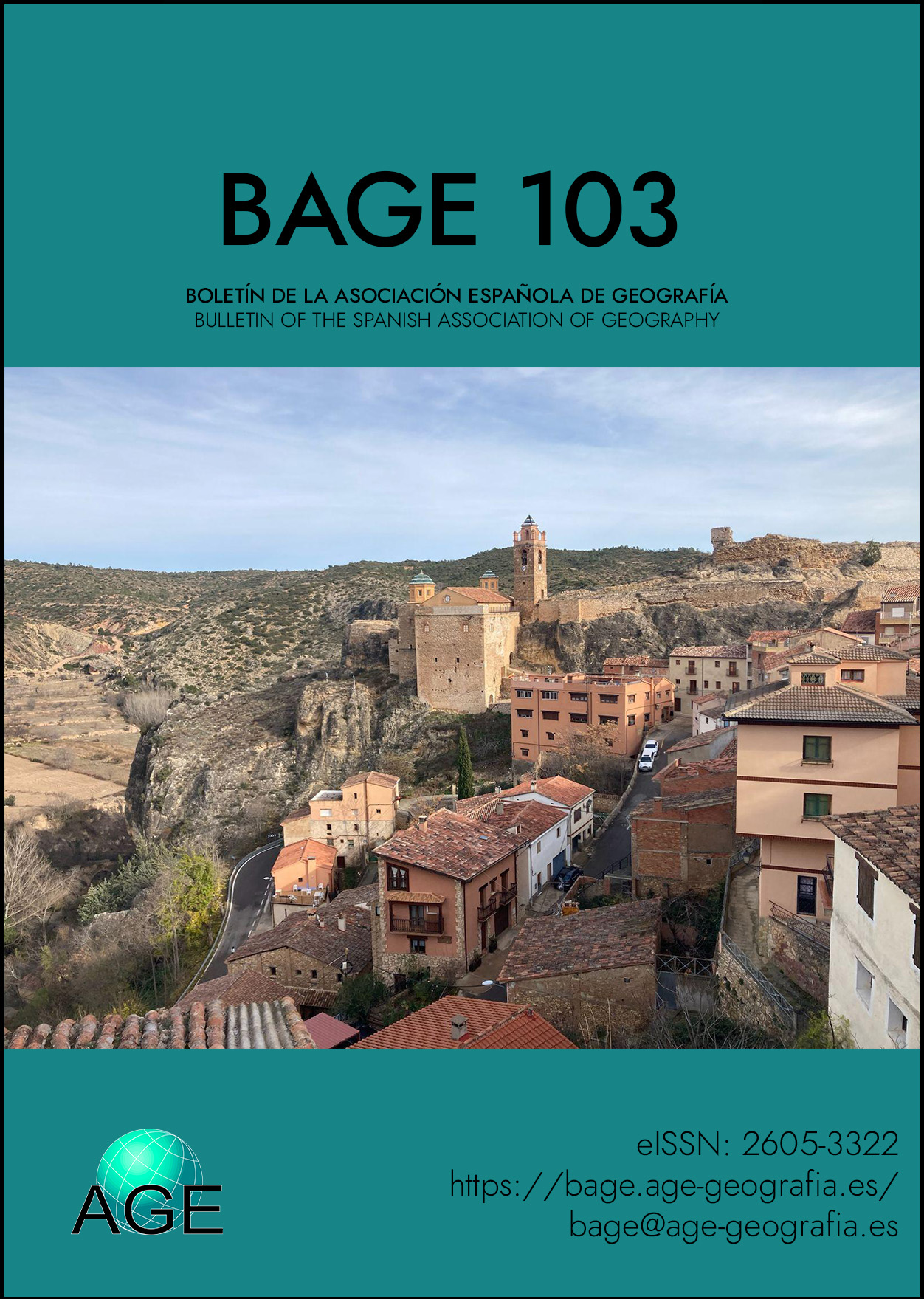Territorios rurales en transformación: desafíos y oportunidades frente al reto de la despoblación
Contenido principal del artículo
Resumen
Los procesos de despoblación rural tienen una manifestación evidente en la pérdida de población residente permanente, y estos tienen a su vez efectos en el parque de viviendas de una gran parte de los pueblos rurales del interior peninsular. La imagen de Castielfabib (Rincón de Ademuz, Valencia; fotografía de Néstor Vercher, diciembre 2023) ilustra esta transformación: viviendas abandonadas o insuficientemente mantenidas conviven con otras rehabilitadas como segundas residencias. De hecho, la mejora y puesta en valor del parque de viviendas se ha convertido en un desafío clave para el mantenimiento de la población y la atracción de nuevos residentes.
Esta localidad, como muchas otras en el interior peninsular, encarna la tensión entre el peso de su patrimonio y la necesidad de adaptación a nuevas dinámicas. El castillo medieval que domina el núcleo urbano –cuyo origen se remonta a la conquista romana (Castellum Fabio)– y la iglesia del siglo XVII representan un legado histórico de gran valor, pero este patrimonio convive con una economía tradicional que, cuando menos, afronta serias dificultades. Efectivamente, la crisis de la agricultura y la ganadería aceleró el abandono de explotaciones ya durante los años 60 y 70 del siglo pasado (como también puede verse en la imagen), reduciendo las oportunidades económicas. Las pequeñas huertas en las riberas de los ríos mantienen cierta actividad, pero el futuro del sector depende de su capacidad de adaptación y revalorización.
En algunos territorios, la transformación de producciones tradicionales ha permitido mejorar la rentabilidad de la actividad agropecuaria, pero no siempre es suficiente para generar un tejido económico dinámico. La articulación y el desarrollo y consolidación de eslabonamientos con sectores complementarios, como el turismo de naturaleza o el turismo residencial, ha surgido como una posible estrategia de revitalización. Ferias y eventos que combinan turismo con valorización de productos locales (como la manzana esperiega en este caso, o los eventos en torno a variedades de tomates autóctonos), contribuyen sin duda esas iniciativas de revitalización socioeconómica de estos territorios rurales.
Sin embargo, para que estas iniciativas sean viables, es imprescindible contar con infraestructuras y servicios adecuados. Aunque los déficits siguen siendo notorios en muchas áreas rurales, se han producido mejoras significativas en movilidad y conectividad (como evidencia la carretera parcialmente visible en la imagen). Modelos innovadores, como el transporte a demanda, comienzan a paliar algunas de las carencias tradicionales, si bien será necesario con iniciativas que superen incluso algunas de sus carencias.
Como se plantea a lo largo del monográfico, la despoblación es un fenómeno multidimensional, donde factores económicos, sociales y ambientales se entrelazan, y ahí reside el futuro de estos territorios. La articulación entre estos elementos resulta clave para las estrategias de retención y asentamiento de población, asegurando que el equilibrio entre identidad y modernidad no se resuelva en una pérdida irreversible del tejido territorial y social.
Rural territories in transformation: challenges and opportunities in the face of the challenge of depopulation
The processes of rural depopulation have an evident manifestation in the loss of permanent resident population, and these in turn have effects on the housing stock of a large part of the rural villages of the peninsular interior. The image of Castielfabib (Rincón de Ademuz, Valencia; photograph by Néstor Vercher, December 2023) illustrates this transformation: abandoned or insufficiently maintained houses coexist with others rehabilitated as second homes. In fact, the improvement and enhancement of the housing stock has become a key challenge for the maintenance of the population and the attraction of new residents.
This town, like many others in the interior of the peninsula, embodies the tension between the weight of its heritage and the need to adapt to new dynamics. The medieval castle that dominates the urban center -whose origin dates back to the Roman conquest (Castellum Fabio)- and the 17th century church represent a historical legacy of great value, but this heritage coexists with a traditional economy that, to say the least, faces serious difficulties. Indeed, the crisis in agriculture and livestock farming accelerated the abandonment of farms already during the 60s and 70s of the last century (as can also be seen in the picture), reducing economic opportunities. Small orchards along the riverbanks maintain some activity, but the future of the sector depends on their capacity to adapt and revalue.
In some territories, the transformation of traditional productions has made it possible to improve the profitability of agricultural activity, but it is not always sufficient to generate a dynamic economic fabric. The articulation, development and consolidation of links with complementary sectors, such as nature tourism or residential tourism, has emerged as a possible revitalization strategy. Fairs and events that combine tourism with the valorization of local products (such as the apple in this case, or the events around local tomato varieties), undoubtedly contribute to these initiatives of socioeconomic revitalization.
However, for these initiatives to be viable, adequate infrastructure and services are essential. Although deficits are still notorious in many rural areas, there have been significant improvements in mobility and connectivity (as evidenced by the partially visible road in the image). Innovative models, such as on-demand transportation, are beginning to alleviate some of the traditional shortcomings, although it will be necessary with initiatives that overcome even some of their shortcomings.
As discussed throughout the monograph, depopulation is a multidimensional phenomenon, where economic, social and environmental factors are intertwined, and therein lies the future of these territories. The articulation between these elements is key to population retention and settlement strategies, ensuring that the balance between identity and modernity does not result in an irreversible loss of the territorial and social fabric.
Descargas
Detalles del artículo

Esta obra está bajo una licencia internacional Creative Commons Atribución-NoComercial 4.0.

